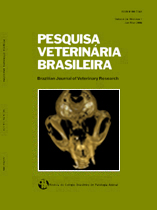 |
|
|
|
Year 2009 - Volume 29, Number 8
|

|
Clinic and pathological findings in dogs naturally infected with canine herpesvirus, 29(8):637-642
|
Abstract.- Oliveira E.C., Sonne L., Bezerra Júnior P.S., Teixeira E.M., Dezengrini R., Pavarini S.P., Flores E.F. & Driemeier D. 2009. [Clinic and pathological findings in dogs naturally infected with canine herpesvirus.] Achados clínicos e patológicos em cães infectados naturalmente por herpesvírus canino. Pesquisa Veterinária Brasileira 29(8):637-642. Setor de Patologia Veterinária, Faculdade de Veterinária, Universidade Federal do Rio Grande do Sul, Av. Bento Gonçalves 9090, Porto Alegre, RS 91540-000, Brazil. E-mail: davetpat@ufrgs.br
The clinic and pathological findings and laboratorial testing of puppies with postmortem diagnosis of canine herpesvirus infection are described. The cases occurred in two households of Porto Alegre, RS, in April 2007 and July 2008. The puppies presented anorexia, depression, cry and dyspnea, followed by death about 24-72 hours after the onset of clinical signs. At necropsy multifocal pin point hemorrhages were observed in the kidneys. The liver was enlarged with petechiae and white foci on the surface. The lungs were red and did not collapse. The spleen was enlarged and, in some cases, with petechiae on the capsular surface. Mesenteric lymph nodes and thymus were enlarged. Microscopic lesions included hemorrhages and multifocal necrosis of the renal tubular epithelial cells, hepatocytes and lymphoid tissues. In the lungs there was severe multifocal alveolar necrosis with abundant fibrin deposits and a mixed inflammatory infiltrate of variable intensity. Intranuclear inclusion bodies were identified in the periphery of necrotic areas in hepatocytes, renal tubular epithelial cells and alveolar cells. Samples of liver, kidney and lung were positive in the direct immunofluorescence test for canine herpes virus type 1 (CHV-1). The diagnosis was based on epidemiological data, necropsy findings, histological lesions and positive immunofluorescence results using CHV-1 antibody in tissue samples. To our knowledge, this is the first report of the identification of CHV-1 in Brazil, although previous clinic and pathological findings already suggested the presence of the virus in Brazilian canine population. |
| |
|
|
| |
|
 |